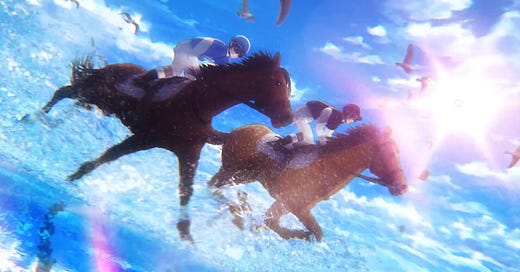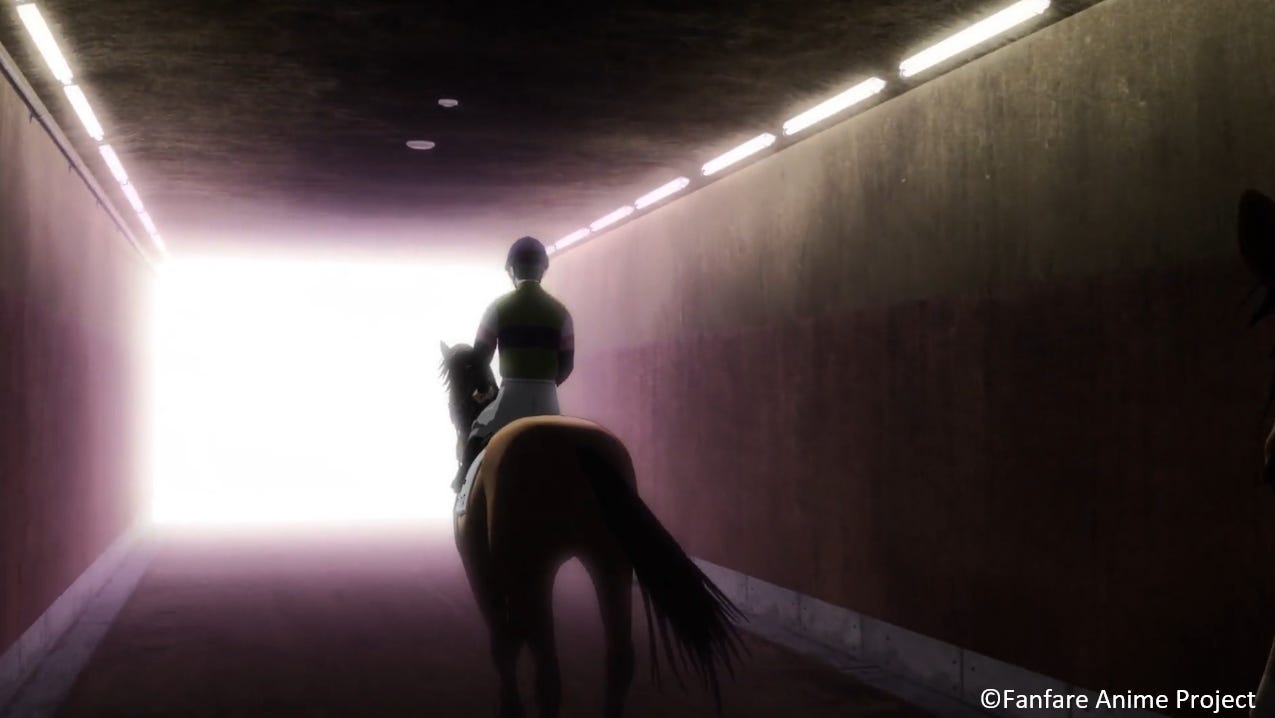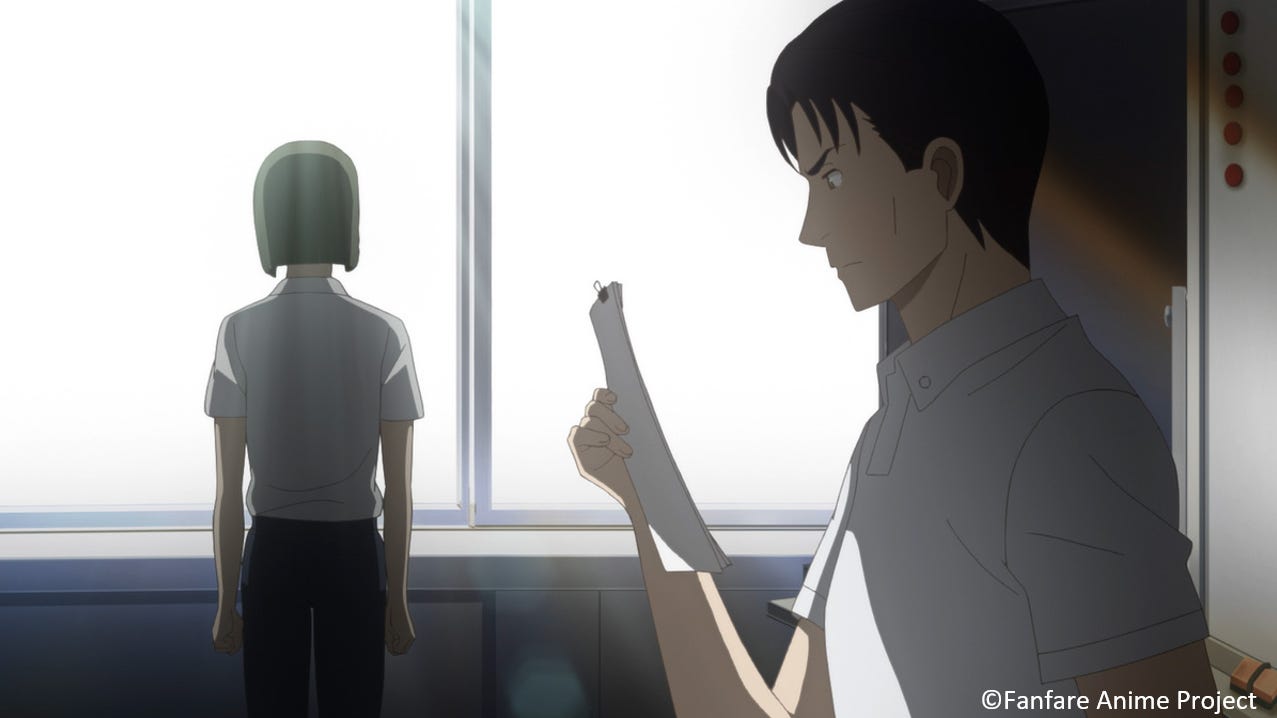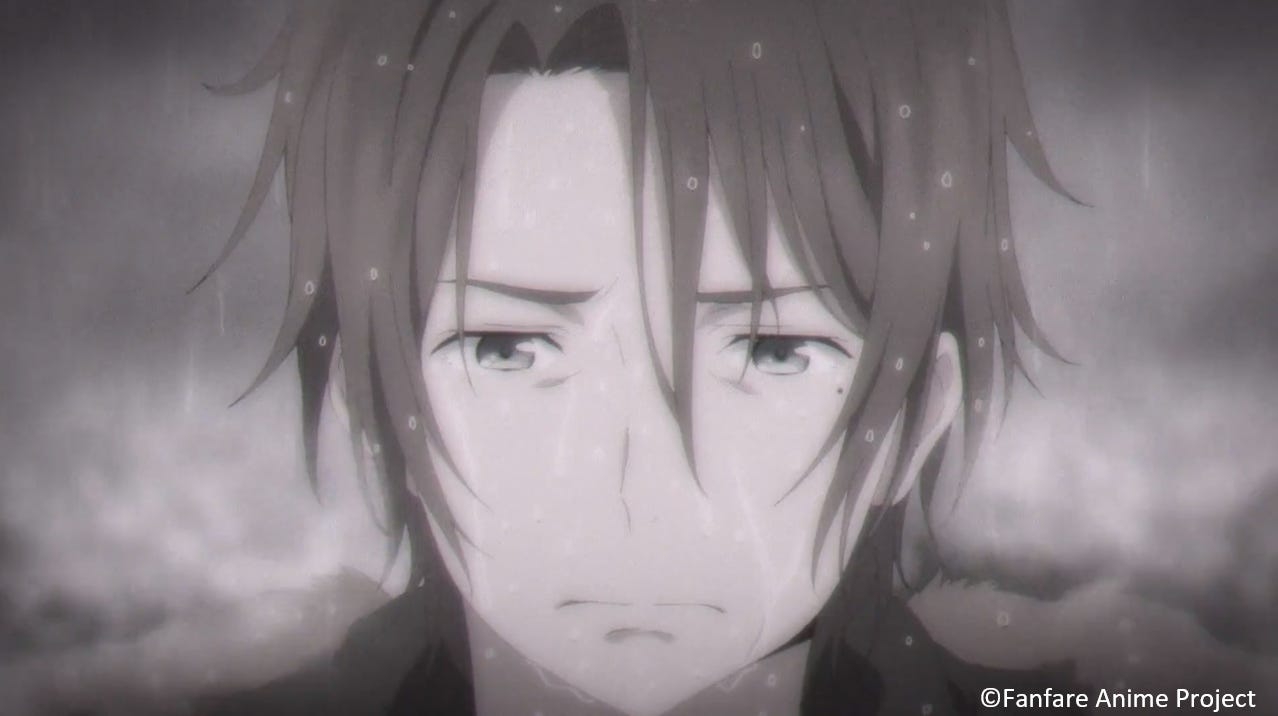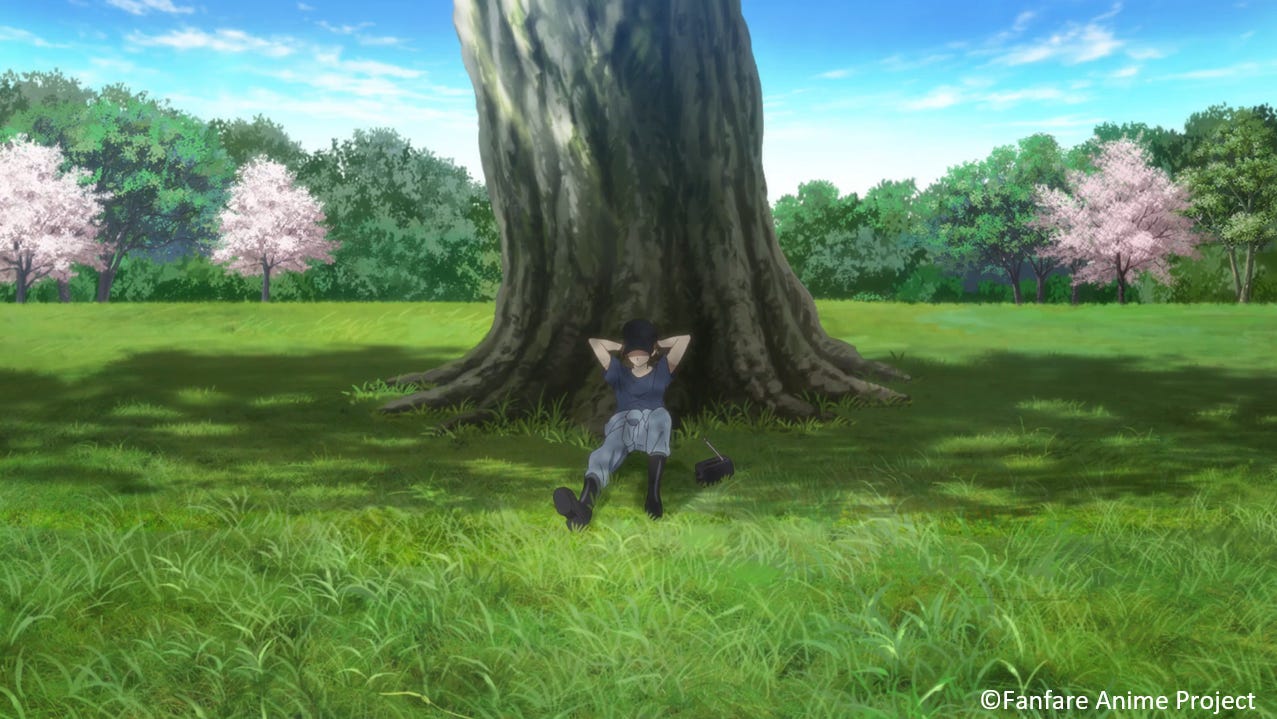Gunjō no fanfāre or Fanfare of Adolescence features a rich ensemble of teenage characters who, except for their common goal to become jockeys, couldn’t be more different. There is the former idol, the innocent country lad, the tsundere fanboy, the Briton, the commoner, the two young elite, and the girl. Thanks to this diverse cast, we get to experience eight different stories. Each has its challenges, from coping with loss to dealing with one’s parentage, being preoccupied with financial issues, or learning about the limits of one’s abilities.
The title Fanfare of Adolescence already hints at the heart of the story: the heralding of puberty. Thus, at first glance, it seems to be a coming-of-age story. But watching the teenagers and their conflicting emotions isn’t all there is to the plot. Read on if you want to find out what else unfolds in the tale.
Of Racing And Pacing
For 13 episodes, we follow the youths’ daily lives as jockeys-in-training, from their first day at school right up until the graduation ceremony. This means that the whole three years of education are squeezed into one season. Pearls of sweat formed on my brow while I was trying to keep up with the incredibly fast pacing, the hurried changes between bathing suits and thermal jackets, and the generous leaps in time. Luckily, we are provided with occasional cues as to the current month and year in the form of calendars, competition schedules, and the like.
Much to my dismay, there were very few races, or at least not as many as I had hoped for. And, unless you were a spectator in the bleachers, you only got to see glimpses of them. This is all the more lamentable because the movement of the artificial-looking horses looked quite decent during the races, compared to their clumsy and unnatural strides when walking, galloping, or jumping over obstacles during training sessions.
As recompense, aspiring jockeys, instructors, and race callers (horse race sportscasters) provided extensive commentary on the races. Unfortunately, the technical remarks on the proceedings of the competition were no compensation for the missing visuals.
The Aspiring Jockeys
The story begins with the 15- and 16-year-old kids entering The Horse Racing School to be educated in the way of the jockey. That’s the actual name of the school, by the way. (Please note, that this is the exact same name as the real The Horse Racing School of the JRA, the Japan Racing Association.)
One of the students, the former idol, Arimura Yū, does his best to avoid being caught on camera. On the other hand, the only girl in the class, Shimotsuki Eri, craves media attention. Contrary to the male characters, who work hard to become good jockeys, the girl seems to rely strongly on her female appeal. According to Eri’s logic, the more (media) attention she gets, the higher the chances are that she will be given a good horse to ride and thereby can earn lots of money. For her, being a jockey is all about the cash. Her classmates repeatedly complain that the reporters are all over her just because she is of the opposite sex.
Being a girl appears to be a huge advantage when it comes to making it as a jockey—at least in the fictitious anime world. Concerning the real world, this would be a rather astonishing revelation, given that jockeying was and still is a male-dominated profession. Women weren’t allowed to enter official races against men with an accredited jockey license until the 1960s and 1970s (US: 1969, Great Britain: 1972, Australia: 1979). The JRA licensed female jockeys for the first time in 1996.
And mind you, ‘Western-style’ horse racing is not a new sport in Japan; it dates way back. It arrived with the British via the port of Yokohama in the 1860s. I assume it was in recognition of this heritage that the British boy Amane Grace was added as a character. The creators designed him to be rather dislikeable, but it's unclear to me why they did so. He is constantly nagging about Japanese rules, belittling training methods, and commenting on the inferiority of Japanese horse racing. His snobbish attitude is ill-founded, though, because Japanese horses and jockeys are serious competitors on the international stage.
The Idol And The Horse Whisperer
Let’s get back to the story. The two main characters are the former singer, Arimura, and the kid from one of the Izu Islands, Kazanami Shun. Arimura just quit being an idol to become a jockey, thereby letting down his fans and depriving his agency of a substantial amount of future earnings. He struggles to free himself of his burdensome past, including the debt he incurred by quitting his job and which he is now obligated to repay. Kazanami just came from the island, where he was occupied with fishing and listening to horse races on the radio, thereby sharpening his sense of hearing to such a degree that he could hear the horses’ voices. His ability to wondrously communicate with the animals is his special gift, but also his downfall. In between their educational pursuits, the two boys come to form a… well, I guess I'll just call it a bromance.
Their first meeting occurs under precarious conditions. On the first day at school, right after the entrance ceremony, two horses shied and took off. Arimura, in a suicidal attempt, tries to stop one of the stampeding animals, and just when he is about to be run over, Kazanami throws himself at the idol, knocking him to the side and thereby saving him from certain death. Having calmed one of the runaway horses, Kazanami and Arimura mount the steed together and race after the second horse, which they manage to capture successfully. This experience marks the beginning of their friendship. Over the course of the series, the two boys come to a profound understanding of each other’s hopes and desires and develop a deep affection for one another. They support each other in times of despair and hopelessness but also share the joyous moments of their teenage lives.
Colors Of The Wind
It wasn’t so very much the emotional depths of the individual stories that kept my eyes glued to the screen, but the way they were depicted. Emotions like joy, despair, and hope; new realizations, difficult decisions, or intricate moods were not expressed in drawn-out conversations but were elaborately reflected with the use of wind and a multitude of colors. Some of the depictions seemed to be a little bit over the top—not to say kitschy—but they were beautifully done. The anime is worth watching just for these scenes, of which there are many, I’m happy to say. And the wind plays a major part in them. It sets the mood by blowing in gentle breezes that cause rosy cherry blossoms to dance through the air. Or it emerges in strong gusts, disturbing the gold-colored autumn leaves in such abundance that the whirling foliage obstructs the view. The wind also creates a peculiar amount of ‘ghost horses’ made up of cherry blossoms, mist, and glimmers of light. Here and there, these translucent creatures gallop unexpectedly through the scenery. It would almost be creepy if they didn’t appear and vanish so elegantly. (You’ll have to watch the beginning and end credits to see them all, though.)
In any case, the creators worked their visual magic in a variety of scenes and settings ranging from wide shots to an extraordinary amount of close-up shots of eyes. After having finished the anime, you will be well acquainted with Arimura’s iris and pupil. Countless times, they reflect obstacles and people placed before them in amazing detail or show a magnificent kaleidoscope of colors to express the youth’s current emotional state. A word of caution is in order here, because these visually delightful images make it all too easy to overlook the other side of the story. And that is the merciless nature of the horse racing business.
Job Description: Basic Qualifications
For teenagers that love horses and want to work with them in their adult life, the anime answers an important question: “Am I cut out to be a jockey?” Let me give it to you straight: if you love horses but dislike dieting; if you are not an egoist, and if winning isn’t everything to you, you’d be better off choosing a different career. Meaning, if all these preconditions do apply, you might just be able to make it as a jockey. Thus, this job is not for altruistic, kindhearted, and compassionate horse lovers. You might be wondering how in the world I came to such a harsh conclusion. Let me explain.
Getting into The Horse Racing School is by no means easy. (There are vocational schools that prepare students for the JRA’s school entrance exam.) But, staying there seems to be equally tough. The first casualty of this brutal reality is Hōshō Hayato. The boy with the bob cut has the luxury of being the school instructor’s son. And, as we find out at the end of the series, being born to the ‘right’ parents—that is, parents who work in the horse racing industry—is just as advantageous as being born as a girl. However, parentage does not matter if your body tends to bulk up and you cannot keep the weight limit which, at graduation, must not exceed 48kg. This prerequisite proved to be detrimental to Hayato and he was forced to retire after half a year.
The second victim to the job’s requirements is Kazanami, the boy from the Izu Islands. The essence of his character is that he loves horses and in particular the chestnut Kisuke (or Oak Nature). His unrestrained emotional attachment to the horses is admired by his friends and supervisors. Only the owner of the racing stable, where Kazanami undertakes his practical training, cautiously expresses concern that this might cause the boy trouble because “Part of this job is seeing horses die.” Her words couldn’t have been truer. When Kisuke had to be put down because he got injured during a race, Kazanami’s world collapsed. Arimura’s emotional support helped him to get back on his feet somewhat, but I guess his fate was sealed the day the chestnut ran his last race.
Just before the graduation race, Kazanami shares the realization with Arimura that “just liking something doesn’t make it a job” and reveals his final decision not to pursue the career of a jockey. This scene displays the symbolic power of wind, color, shadow, and light and is easily the most beautiful one in the anime. There is little dialogue, but the scenery speaks volumes and conveys the character’s feelings of sorrow, relief, shock, and hope to the viewers.
After all this heartbreak, let me give you some uplifting news. So, wipe away your tears and put away the tissues, because there is a life after having quit the jockey school. Hayato, we are informed, is going to be a veterinarian, and Kazanami found a job at the breeding farm, where Kisuke was born. In the end, all is well.
Wanted: Soldiers And Egoists
Now that we know what doesn’t qualify one as a jockey, let’s take a closer look at what does. First off, jockeys are soldiers. They do as they are told and care only about victory; they need to win. Pro-jockey Kuji, Arimura’s senpai, explains: “Our job is to place the horse as high as possible! That’s the only thing we live for!” Kuji’s attitude is understandable considering how short-lived a jockey’s career can be. Sumeragi, the owner of one of the racing stables, phrases it as follows: “If the jockey doesn’t do what we say and then fails to get results, we can get rid of him.” Phew… what a tough industry to work in.
Asahi, an instructor at The Horse Racing School, specifies another character trait of a jockey: “A jockey has to believe that his own way is the best. Lonely. Selfish. Fighting those around him.” Some minions do all the other work for and with the horses, like feeding and stuff, but in essence, the jockey fights alone. Hence, they must also be egoists. Kazanami, for example, was too kindhearted to handle the pain of seeing his classmate lose a race, which was a further reason why he quit being a jockey.
Hush, hush!
Some issues—rather important ones, I’d say—are given the ‘silent treatment’. For example, betting gets a mere five seconds of screen time. It shows the instructor’s stern “No!” when the girl jockey, Eri, gets all excited at the prospect of placing a bet in one of the races. This negligent treatment doesn’t do the issue justice, considering that Japan is the country with the highest betting turnover in the world—¥ 3,091,112,025,800 (or 3.09 trillion Yen) in 2021. Knowing this, it might not come as a surprise that the students bet anyway, despite the teacher’s disapproval and the fact that they are still too young. The legal age for gambling in Japan is 20. Just to clarify, the students bet amongst each other, wagering their toilet cleaning duties.
Kisuke, the horse that had to be put down, should have gone off to his well-earned retirement after the race that cost him his life. Kazanami imagined the chestnut living his twilight years plucking clover and chasing butterflies. “But that’s not what usually happens,” the owner of the horse breeding farm cares to explain. He doesn’t elaborate on this, so I looked a little into it myself and found out that veteran horses are usually put to other uses or culled. Not quite what Kazanami had in mind when they were talking about Kisuke’s retirement.
Name Dropping
Last but not least, the anime allows us to catch a glimpse of the complexity of racetracks, competitions, and trophies. Unless you are already an expert, you might want to take a little stroll online to dig up some information on the difference between a derby and a cup, or which races make up the Triple Crown (of which there are two), or what the difference between the JRA and the NAR is.
I will just tell you a little bit about the upcoming and most important race in Japan, the Japan Cup. First held in 1981, it is now organized every year in November at the Tōkyō racecourse and will be held this year on November 27. The promotion video for this race reminded me a little of the anime, using slow motion, apt color combinations, symbolic imagery, and carefully chosen vocabulary to stir emotions and emphasize the ‘Japaneseness’ of horse racing. The only thing that is missing is the ever-blowing wind.
In conclusion, the anime is about coming-of-age in the horse racing industry. The teenagers are rather superficially portrayed, as they contain a single, yet decisive, character trait, and there is only one challenge each of them grapples with. A (thorough) depiction of critical issues concerning the horse racing industry is expertly avoided. Visually, however, it is an impressive anime. So, if you want to accompany teenagers on their emotional journeys while being dazzled by a plethora of colors, Gunjō no fanfāre is a good choice.
Website: Gunjō no fanfāre
Horse racing in Japan: JRA and NRA

